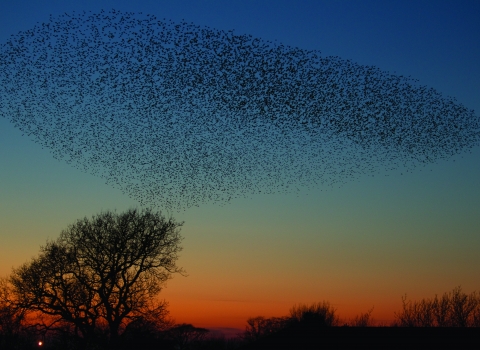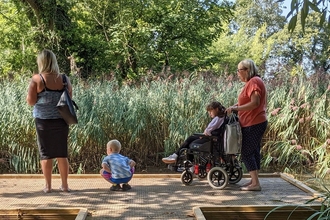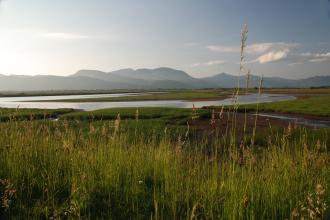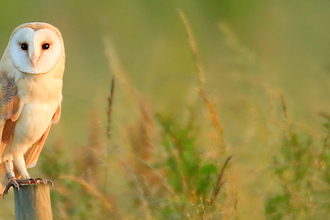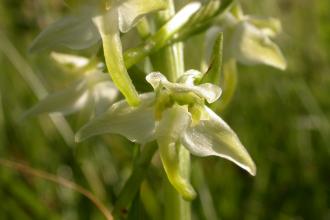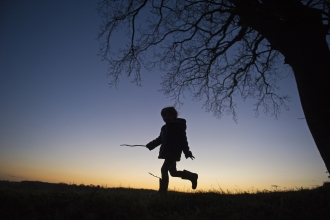Bird migration
Whether flying from the south to breed in the spring, or from the north in the winter in search of food and milder climes, or simply passing through on their journey, bird migration is one of the UK’s most impressive natural events. Witness the comings and goings of flocks over the year, while remembering to look out for those preferring to fly solo. Cuckoos in April, Arctic wading birds in July, and Europe’s smallest bird in October, the goldcrest, weighing the same as a ten pence piece yet, incredibly, able to journey across the North Sea to spend its winter here.
There are few more awe-inspiring wildlife experiences than watching migrating birds pass by, marvelling at the distances they’ve travelled, and how far they still have to go.
Where to see migratory birds
Do a little research in advance and find some of the best North Wales Wildlife Trust reserves to see migratory birds. Flocking birds are highly mobile and don’t always turn up when you hope! It's worth contacting us in advance to find out which visitors are around, and remember to bear in mind the time of year - we've shared some seasonal highlights below this list of reserves!
What to look out for
Be prepared for an early start, as sometimes the first few hours of the day are the busiest. Bring some sandwiches! You won’t want to miss a moment of the action having to go looking for some lunch.
The major migration hotspots are around our coasts, especially during the spring, but autumn migration can be seen almost anywhere in the country. Compared to the great rush north, when all the birds are arriving at the same time to grab as much of the spring as they can and get on with the vital task of breeding, birds take the journey south in stages, stopping to refuel and socialise on the way. Here are some of our highlights to watch out for:
Spring
Spring migration is known as the great rush north, as birds race back to their more northerly breeding grounds having spent the winter in milder regions further south. There's an air of urgency, each bird eager to claim the best territory or find the best mate, so most spring migrants rarely pause in one place for long until they've reached their final destination.
Spring sees the return of many of our summer visitors, birds that breed in the UK but winter in southern Europe, Africa or even further afield. Many of these are insect-eaters, which can't find enough food here in winter. They can appear as early as March, with wheatears, chiffchaffs, sand martins and ring ouzels often the first to arrive.
Things heat up in April, with more birds arriving all the time. Swallows, willow warblers, blackcaps, redstarts, tree pipits, yellow wagtails and house martins are often spotted early in the month, with later arrivals including garden warblers, swifts and pied and spotted flycatchers. April also sees the return of the cuckoo, whose call is widely regarded as the classic sign of spring.
Breeding seabirds also arrive on our shores in spring. Arctic, common, Sandwich and little terns can sometimes be seen flying around our coast. Puffins, guillemots, razorbills and gannets all reappear at their breeding grounds on rocky cliffs or islands after spending the winter out at sea. Birds of prey are another feature of spring migration, with summer visitors including ospreys, hobbies and the rarely seen honey buzzard.
Spring is also a good time to find rarer migrants that don't typically breed in Wales. Easterly winds can push migrating birds off-course, resulting in scarcely-seen species like wrynecks and bluethroats being found on our shores. Southerly winds and favourable conditions can cause birds that usually breed further south to fly too far, hitting Wales instead. Hoopoes, bee-eaters and black-winged stilts are sometimes encountered.
Summer
In early summer most birds are busily raising chicks, but with no parental duties to worry about adult cuckoos are already heading south in June. By July they can be back in the Sahel, feasting on the caterpillars of African moths and planning the next leg of their journey to the rainforests of central Africa.
July sees the first migratory wading birds returning to our coasts and wetlands, busily feeding and re-stocking their fat reserves for the last push of their journey down to Africa or beyond. Wader migration steps up a gear in August, and with luck scarcer species like little stint and curlew sandpiper can be spotted.
July is also when terns start to spread out from their breeding colonies and can be found scattered around our coasts, preparing for their own journey south. For Arctic terns, this journey could take them as far as Antarctica. They make the longest migration ever recorded, clocking up over 59,000 miles; an incredible distance equivalent to flying twice around the planet!
During August, swifts start out on their non-stop flight down to South Africa. Swallows and house martins start gathering in August and September, forming large flocks at reedbeds and famously lining up along telegraph wires before they too decide it’s time to leave, flying their way back down across Europe and the Mediterranean, heading for Botswana.
Autumn
Autumn migration has a very different feel to the great northerly rush of spring. The urgency is gone, birds slowly working their way south and often stopping off for days or even weeks to refuel for the rest of their journey.
As our own summer visitors gradually disappear, birds that spent the summer in more northerly countries start to pass through on their way south. Thousands of flycatchers, chats and warblers arrive on our coasts from Scandinavia, all with one thing on their mind: the journey to Africa.
Thousands of auks, kittiwakes and gannets leave their colonies and head out into the Bay of Biscay and the North Atlantic for the winter. The tiny red-necked phalarope, a sparrow-sized wader that breeds on pools in Shetland, has the Herculean task ahead of not only flying right across the Atlantic but then flying right across the Americas to spend the winter months in the equatorial Pacific, bobbing around on the seas surrounding the Galapagos islands.
In October, it’s the turn of thrushes and buntings, and thousands of swans and geese, flying in their famous V-formations. Waxwings arrive for the winter from Scandinavia, and you might also see large numbers of the delicate goldcrest, Europe’s smallest bird weighing the same as a ten pence piece and yet able to make its way across the North Sea to spend its winter here with us.
Winter
Many of the birds that winter in the UK arrive in autumn, but cold weather or a lack of food in northern Europe can drive large numbers of birds to cross the North Sea.
Waxwings are the most eagerly anticipated winter arrivals, their colourful plumage making them a favourite of many UK birdwatchers. Some winters only see a handful of these beautiful birds making the journey to our shores, but in other years they appear in huge numbers. These mass influxes are known as irruptions, and occur when the weather in Scandinavia and northern Russia is particularly harsh, or if there has been a poor crop of their favourite food, berries. Waxwings are often found in supermarket carparks, feasting on berry-laden trees.
Late December into January also tends to be when the highest number of smews can be seen in the UK. The striking black and white males don't stray far from their continental breeding grounds, so most individuals seen here are either females or young birds, known as red-heads thanks to the auburn feathers on their crown and nape. Smew favour gravel pits, but can be found on almost any large body of freshwater.
If you can't get to these places
Don’t worry if you can’t make it to one of these sites as large flocks can still be seen elsewhere in towns and the wider countryside. Gatherings of swifts can be seen in the summer while during October large numbers of winter thrushes, redwings and fieldfares arrive from Scandinavia. On a dark night, stand quietly for a while and listen. You may well hear the high pitched ‘seep’ of redwings flying over in the dark. Long-tailed tits can often be seen gathering in large numbers in trees in urban areas, too.
More wildlife experiences
From seeing colourful wildflowers to spotting magnificent birds of prey, we can help you get closer to wildlife across North Wales.

